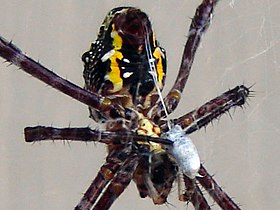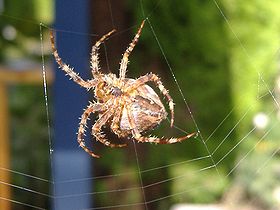Silk

Silk dresses
Silk is a natural
protein
fiber, some
forms of which can be
woven into
textiles.
The best-known type of silk is obtained from
cocoons
made by the larvae
of the
silkworm
Bombyx
mori reared in captivity (sericulture).
The shimmering appearance for which silk is prized comes from the fibers'
triangular
prism-like structure which allows silk cloth to refract incoming light at
different angles.
"Wild silks" or tussah silks (also spelled "tasar") are produced by
caterpillars other than the
mulberry
silkworm (Bombyx
mori). They are called "wild" as the silkworms cannot be artificially
cultivated like Bombyx mori. A variety of wild silks have been known
and used in China,
India, and
Europe from
early times, although the scale of production has always been far smaller than
that of cultivated silks. Aside from differences in colors and textures, they
all differ in one major aspect from the domesticated varieties: the cocoons
that are gathered in the wild have usually already been damaged by the
emerging moth before the cocoons are gathered, and thus the single thread that
makes up the cocoon has been torn into shorter lengths. Commercially reared
silkworm pupae are killed before the adult moths emerge by dipping them in
boiling water or piercing them with a needle, thus allowing the whole cocoon
to be unraveled as one continuous thread. This allows a much stronger cloth to
be woven from the silk. Wild silks also tend to be more difficult to dye than
silk from the cultivated silkworm.
There is some evidence that small quantities of wild silk were already
being produced in the Mediterranean area and the Middle East by the time the
superior, and stronger, cultivated silk from China began to be imported
(Hill 2003, Appendix
C).
Silks are produced by several other insects, but only the silk of moth
caterpillars has been used for textile manufacture. There has been some
research into other silks, which have differences at the molecular level.
Silks are mainly produced by the
larvae of
insects with
complete metamorphosis, but also by some adult insects such as
webspinners. Silk production is especially common in the
Hymenoptera (bees,
wasps, and
ants), and is
sometimes used in nest construction. Other types of
arthropod
produce silk, most notably various
arachnids
such as spiders
(see
spider silk).
Spider silk
Spider silk, also known as
gossamer,
is a fibre spun
by spiders.
Spider silk is a
remarkably strong material. Its
tensile strength is comparable to that of high-grade
steel — according
to
Nature[1],
spider dragline silk has a tensile strength of roughly 1.3 GPa,
while one source
[2] lists a tensile strength for one form of steel at 1.65 GPa. However,
spider silk is much less dense than steel; its tensile strength to density ratio
is roughly five times higher than that of
steel (i.e. it is
five times as strong as steel of the same density — as strong as
Aramid
filaments, such as
Twaron or
Kevlar.) In fact, a strand of spider silk long enough to circle the earth
would weigh less than 16 ounces
(454 g).
Usage
Spiders normally use their silk to make structures, either for protection for
their offspring, or for predation on other creatures. They can also suspend
themselves using their silk, normally for the same reasons.
The
trapdoor spider will burrow into the ground and weave a
trapdoor-like
structure with spindles around so it can tell when prey arrives and take it by
surprise.
Many small spiders use silk threads for
ballooning. They extrude several threads into the air and let themselves
become carried away with upward winds. Although most rides will end a few meters
later, it seems to be a common way for spiders to invade islands. Many sailors
have reported that spiders have been caught in their ship's sails, even when far
from land.
Argiope argentata has five different types of silk, each for a different
purpose:[2][3]
- dragline silk: Used for the web's outer rim and spokes, as well as
for the
lifeline. As strong as steel, but much tougher. - capture-spiral silk: Used for the capturing lines of the web.
Sticky, extremely stretchy and tough. - tubiliform silk: Used for protective egg sacs. Stiffest silk.
- aciniform silk: Used to wrap and secure freshly captured prey. Two
to three times as tough as the other silks, including dragline. - minor-ampullate silk
Properties
Structure of spider silk. Inside a typical fiber, one finds crystalline
regions separated by amorphous linkages. The crystals are beta-sheets that
have assembled together.
Spider silk is also especially
ductile, able
to stretch up to 40% of its length without breaking. This gives it a very high
toughness
(or work to fracture), which "equals that of commercial
polyaramid (aromatic
nylon) filaments,
which themselves are benchmarks of modern polymer fiber technology."[4]
The notion that spider silk is stronger than any industrial fiber is a common
misconception as whilst some may be stronger, none are tougher (total energy to
break). Numerous artificial fibers are similar or stronger, notably
aramids like
Kevlar and
carbon
fibre materials (see
tensile strength for common comparisons). Nonetheless, there is much
interest in duplicating the silk process artificially, since spiders use
renewable materials as input and operate at room temperature, low pressures and
using water as a solvent. Spider silk can be harvested in large scale quantities
if one has proper harvesting equipment. One can also make near-indestructible
spider silk threads by weaving the fine threads into thicker and more durable
weaves in the same fashion as other industrial threads.
Spider silk is composed of complex
protein
molecules.
This, coupled with the isolation relating from the spider's
predatory
nature, has made the study and replication of the substance quite challenging.
Because of the repetitive nature of the
DNA encoding the silk
protein, it is difficult to determine its
sequence
and to date, silk-producing sequences have only been decoded for fourteen
species of
spider. In 2005, independent researchers in the
University of Wyoming (Tian and Lewis),
University of the Pacific (Hu and Vierra), the
University of California at Riverside (Garb and Hayashi) and
Shinshu University (Zhao and Nakagaki) have uncovered the molecular
structure of the gene for the protein that various female spider species use to
make their silken egg cases.
Although different species of spider, and different types of silk, have
different protein sequences, a general trend in spider silk structure is a
sequence of amino acids (usually alternating
glycine and
alanine, or
alanine alone) that
self-assemble into a
beta sheet
conformation. These "Ala rich" blocks are separated by segments of amino acids
with bulky side-groups. The beta sheets stack to form
crystals,
whereas the other segments form
amorphous
domains. It is the interplay between the hard crystalline segments, and the
elastic semi amorphous regions, that gives spider silk its extraordinary
properties.



































No comments:
Post a Comment